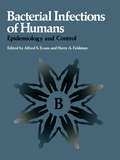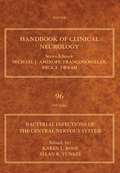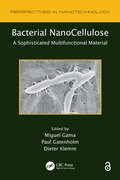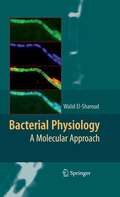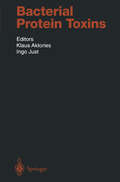- Table View
- List View
Bacterial Infections of Humans: Epidemiology and Control
by Alfred S. Evans Harry A. FeldmanThis is a companion volume to Viral Infections of Humans: Epidemiology and Control. The apparent success of that book in bridging the gap between texts on basic microbiology and those on clinical infectious diseases led to editing this one on bacterial infections, the chapters of which are organized in exactly the same format of 12 units: introduction, historical background, methodology, biological characteristics of the organism, descriptive epidemiology, mechanisms and routes of transmission, pathogenesis and im munity, patterns of host response, control and prevention, unresolved problems, references, and suggested reading. The purpose of this book is to provide a description and understanding of the pathogenesis of infection and disease both within the community and within the individual. This is done in the belief that a variety of factors in both the external and the internal environment, and in the nature of the infectious agent, influence exposure, the development of infection, and the pattern of the host response. An understanding of the epidemiology and pathogenesis of these processes forms the basis for approaches to control and prevention. The first two chapters of this book deal with general epidemiological concepts and with surveillance.
Bacterial Infections of the Central Nervous System (ISSN #Volume 96)
by Karen L. Roos Allan R. TunkelBacterial Infections of the Central Nervous System aims to provide information useful to physicians taking care of patients with bacterial infections in the central nervous system (CNS), which can lead to morbidity and mortality. The increased number of patients suffering from this infection has led to the development of vaccines and antibiotics. Comprised of four chapters, the book explains the general approach to patients with bacterial CNS infection. It also discusses various CNS infection concepts and terms. These include the characteristic neuroimaging appearance of specific bacterial infections, the limitations of neuroimaging, the cerebrospinal fluid analysis, the pathogenesis and pathophysiology of bacterial CNS infections, the developments of specific adjunctive strategies, and the principles of antimicrobial therapy. It also includes discussions on various diseases that target the CNS, such as meningitis, focal CNS infections, neurological complications of endocarditis, suppurative venous sinus thrombosis, infections in the neurosurgical patient, and CNS diseases caused by selected infectious agents and toxins. This book will serve as a guide for clinical physicians who have patients suffering from bacterial CNS infection. Valuable insights into the pathophysiological mechanism of bacterial CNS infections A multidisciplinary reach that provides critical information for neurologists, neurosurgeons, and specialists in infectious disease Considerable information and emphasis on new diagnostic techniques and laboratory testing
Bacterial Invasion into Eukaryotic Cells: Subcellular Biochemistry (pdf) (Subcellular Biochemistry #33)
by Tobias A. Oelschlaeger Jörg H. HackerBacterial Invasiveness (Current Topics in Microbiology and Immunology #209)
by Virginia L. MillerIntracellular pathogens are responsible for a number of important diseases worldwide, including tuberculosis, plague and bacillary dysentery. This volume focusses on those intracellular pathogens that have been studied most extensively at the molecular, genetic, and cellular level. The reviews attempt to integrate the information derived from these diverse approaches into a cohesive picture. In recent years the entry steps have been described at the molecular and genetic level, and the important signal transduction events are being elucidated. It is now becoming clear that there are both similarities and differences both in terms of the steps involved and of the genetic basis of bacterial invasiveness. These reviews of the "state of the art" provide a foundation from which to proceed.
Bacterial Lipopolysaccharides: Structure, Chemical Synthesis, Biogenesis and Interaction with Host Cells
by Yuriy A. A. Knirel and Miguel A. A. ValvanoThe bacterial lipopolysaccharide also known as endotoxin is exhaustively covered in the present work. Central emphasis is placed upon the fine chemical structure of the lipopolysaccharide and its significance for understanding their activity and function. In particular, the role it plays in the interaction of bacteria with other biological systems is examined. New aspects of their physicochemical biology are introduced and updates to the current knowledge concerning the lipopolysaccharide are provided. This important class of biomolecules has recently attracted the attention of many investigators, in particular for understanding its involvement in innate immunity, toll-like receptor recognition and intracellular signaling.
Bacterial Metabolism (Springer Series in Microbiology)
by Gerhard GottschalkThis concise yet comprehensive text surveys the field of bacterial metabolism in terms useful to students and researchers. Emphasis is on those metabolic reactions occurring only in bacteria. Thus, the book describes in detail the energy metabolism of the various groups of bacteria. In addition, it examines pathways used by bacteria for the degradation of organic compounds, the synthesis of cellular constituents, the regulation of bacterial metabolism and the fixation of molecular nitrogen.
Bacterial Multidrug Exporters: Methods and Protocols (Methods in Molecular Biology #1700)
by Akihito Yamaguchi and Kunihiko NishinoThis detailed volume utilizes our current understanding of the structural basis of multidrug recognition and multidrug efflux mechanisms to provide protocols involving these vital intrinsic membrane proteins widely distributed in bacteria. Beginning with protocols for the structural analysis of bacterial multidrug exporters, the book continues with sections on biochemical and bioengineering analysis, computational analysis, biomedical approaches, as well as advanced technologies expected to be applied to multidrug efflux transport studies. Written in the highly successful Methods in Molecular Biology series format, chapters include introductions to their respective chapters, lists of the necessary materials and reagents, step-by-step, readily reproducible laboratory protocols, and tips on troubleshooting and avoiding known pitfalls. Authoritative and practical, Bacterial Multidrug Exporters: Methods and Protocols serves as an ideal guide to this fast moving field of study.
Bacterial NanoCellulose: A Sophisticated Multifunctional Material (Perspectives In Nanotechnology Ser. #9)
by Miguel GamaThe first book dedicated to the potential applications and unique properties of bacterial cellulose (BC), this seminal work covers the basic science, technology, and economic impact of this bulk chemical as well as the companies and patents that are driving the field. It reviews the biosynthesis and properties of BC, including genetics and characterization; discusses the advancing technology as it relates to product development, bioreactors, and production; and analyzes the economic impact of BC on a diverse range of industry applications, including materials and biomaterials, biological and polymer sciences, and electromechanical engineering.
Bacterial NanoCellulose: A Sophisticated Multifunctional Material
by Miguel Gama Paul Gatenholm Dieter KlemmeBacterial nanocellulose (BNC) is an emerging nanomaterial with unique properties produced by several species of ubiquitous fermentation bacteria, most importantly Gluconacetobacter xylinus, previously known as Acetobacter xylinum. BNC has been used for a variety of commercial applications including textiles, cosmetics, and food products, and it has
Bacterial Pathogenesis: Methods and Protocols (Methods in Molecular Biology #431)
by Frank R. DeLeo and Michael OttoBacterial infections affect world health today as a leading cause of morbidity and mortality. This book presents in-depth methods and state-of-the-art protocols for investigating specific mechanisms of pathogenesis for a wide range of bacteria. Written by experts in the field, this invaluable collection includes protocols to study host-pathogen interactions, animal models of infection, and novel approaches to identifying therapeutic targets designed to control infections.
Bacterial Pathogenesis: Methods and Protocols (Methods in Molecular Biology #2674)
by Pontus Nordenfelt Mattias CollinThis detailed volume presents a diverse set of methodological approaches designed to improve our understanding of bacterial infections from a wide range of bacterial species. Beginning with biofilms and subcellular compartments, the book explores transcriptional analysis, methods for studying plasmid dynamics, and tools for phylogenetic analysis of bacterial genomes, as well as bacterial effector proteins interfering with host systems, host response analysis, and in vivo and in vitro infection models. Written for the highly successful Methods in Molecular Biology series, chapters include introductions to their respective topics, lists of the necessary materials and reagents, step-by-step and readily reproducible laboratory protocols, and tips on troubleshooting and avoiding known pitfalls. Authoritative and up-to-date, Bacterial Pathogenesis: Methods and Protocols, Second Edition is a vital resource for researchers in the area of infection biology, as well as but not limited to, those working in the fields of microbiology, immunology, structural biology, molecular biology, genetics, imaging, and computational study.
Bacterial Pathogenesis: A Molecular Approach (ASM Books)
by Brenda A. Wilson Malcolm Winkler Brian T. HoThis highly anticipated update of the acclaimed textbook draws on the latest research to give students the knowledge and tools to explore the mechanisms by which bacterial pathogens cause infections in humans and animals. Written in an approachable and engaging style, the book uses illustrative examples and thought-provoking exercises to inspire students with the potential excitement and fun of scientific discovery. Completely revised and updated, and for the first time in stunning full-color, Bacterial Pathogenesis: A Molecular Approach, Fourth Edition, builds on the core principles and foundations of its predecessors while expanding into new concepts, key findings, and cutting-edge research, including new developments in the areas of the microbiome and CRISPR as well as the growing challenges of antimicrobial resistance. All-new detailed illustrations help students clearly understand important concepts and mechanisms of the complex interplay between bacterial pathogens and their hosts. Study questions at the end of each chapter challenge students to delve more deeply into the topics covered, and hone their skills in reading, interpreting, and analyzing data, as well as devising their own experiments. A detailed glossary defines and expands on key terms highlighted throughout the book. Written for advanced undergraduate, graduate, and professional students in microbiology, bacteriology, and pathogenesis, this text is a must-have for anyone looking for a greater understanding of virulence mechanisms across the breadth of bacterial pathogens.
Bacterial Pathogenesis: A Molecular Approach (ASM Books)
by Brenda A. Wilson Malcolm Winkler Brian T. HoThis highly anticipated update of the acclaimed textbook draws on the latest research to give students the knowledge and tools to explore the mechanisms by which bacterial pathogens cause infections in humans and animals. Written in an approachable and engaging style, the book uses illustrative examples and thought-provoking exercises to inspire students with the potential excitement and fun of scientific discovery. Completely revised and updated, and for the first time in stunning full-color, Bacterial Pathogenesis: A Molecular Approach, Fourth Edition, builds on the core principles and foundations of its predecessors while expanding into new concepts, key findings, and cutting-edge research, including new developments in the areas of the microbiome and CRISPR as well as the growing challenges of antimicrobial resistance. All-new detailed illustrations help students clearly understand important concepts and mechanisms of the complex interplay between bacterial pathogens and their hosts. Study questions at the end of each chapter challenge students to delve more deeply into the topics covered, and hone their skills in reading, interpreting, and analyzing data, as well as devising their own experiments. A detailed glossary defines and expands on key terms highlighted throughout the book. Written for advanced undergraduate, graduate, and professional students in microbiology, bacteriology, and pathogenesis, this text is a must-have for anyone looking for a greater understanding of virulence mechanisms across the breadth of bacterial pathogens.
Bacterial Pathogenesis of Plants and Animals: Molecular and Cellular Mechanisms (Current Topics in Microbiology and Immunology #192)
by Jeffrey L. DanglThe last decade has seen an explosion in our understanding of how bacterial pathogens trick, cajole, usurp and parasitize their various hosts. This renaissance is due to the convergence of molecular and cellular techniques with the power of microbial genetics. The purpose of this volume is to introduce recent advances in understanding selected systems chosen from both plant and animal hosts of bacterial pathogens. This somewhat nonobvious choice of topics was spurred by the recent findings, detailed by several conributors to this volume, of common systems used to secrete virulence factors from pathogens of both plants and animals. These serendipitous findings underscored the importance of basic research approaches to parallel problems in biology. More importantly, they brought together investigators who may not have otherwise become conversant with each other's experimental systems. I, for one, find the kinds of synergism reflected in a volume of this sort to be one of the most pleasant aspects of science and hope that the reader, whether a newcomer to the field or an expert, can find a new slant to old problems in the reviews contained h,E:lre. It was, however, necessary to limit volume length, and this has forced the exclusion of a number of fascinating bacterial pathosystems.
Bacterial Pathogens and Their Virulence Factors
by Douglas I. JohnsonBacterial Pathogens and their Virulence Factors contains a detailed description of 32 major bacterial pathogens that affect human health and their associated virulence determinants. Chapter 1 gives an overview of the different types and classes of general virulence factors involved in host cell adherence and invasion, dissemination within the host, host cell damage, and evasion of host defense systems, as well as mechanisms by which these virulence factors are regulated. Chapters 2 through 33 give concise descriptions of the disease states associated with the 32 bacterial genera and their major pathogenic species, along with an in-depth description of the individual virulence factors that have been found to be functionally involved in pathogenicity. A detailed bibliography derived from primary literature and review articles accompanies each of these chapters, allowing the reader to delve more deeply into individual pathogens and their virulence determinants. Chapter 34 discusses the exciting possibilities and initial successes of using detailed information on a pathogen’s virulence toolkit to design new therapeutics aimed at specific virulence traits.
Bacterial Persistence: Methods and Protocols (Methods in Molecular Biology #1333)
by Jan Michiels and Maarten FauvartThis volume presents a comprehensive collection of methods that have been instrumental to the current understanding of bacterial persisters. Chapters in the book cover topics ranging from general methods for measuring persister levels in Escherichia coli cultures, protocols for the determination of the persister subpopulation in Candida albicans, quantitative measurements of Type I and Type II persisters using ScanLag, to in vitro and in vivo models for the study of the intracellular activity of antibiotics. Written in the highly successful Methods in Molecular Biology series format, chapters include introductions to their respective topics, lists of the necessary materials and reagents, step-by-step, readily reproducible laboratory protocols, and tips on troubleshooting and avoiding known pitfalls.Authoritative and cutting-edge, Bacterial Persistence: Methods and Protocols brings together the most respected researchers in bacterial persistence whose studies will remain vital to understanding this field for many years to come.
Bacterial Persistence: Methods and Protocols (Methods in Molecular Biology #2357)
by Jan Michiels Natalie VerstraetenThis volume presents a collection of methods that have contributed to the current understanding of bacterial persisters. Chapters in the book detail general guidelines for measuring persister levels in bacterial cultures, strategies to enrich and resuscitate persister subpopulations, single-cell approaches for visualizing and characterizing persisters, omics techniques and cellular and animal models for studying persistence. Written in the highly successful Methods in Molecular Biology series format, chapters include introductions to their respective topics, lists of the necessary materials and reagents, step-by-step, readily reproducible laboratory protocols, and tips on troubleshooting and avoiding known pitfalls. Authoritative and cutting-edge, Bacterial Persistence: Methods and Protocols, Second Edition aims to be a useful practical guide to researchers to help further their study in this field.
Bacterial, Phage and Molecular Genetics: An Experimental Course
by U. Winkler W. Rüger W. WackernagelBacterial Physiology: A Molecular Approach
by Walid El-SharoudThe application of new molecular methodologies in the study of bacterial behavior and cell architecture has enabled new revolutionary insights and discoveries in these areas. This new text presents recent developments in bacterial physiology that are highly relevant to a wide range of readership including those interested in basic and applied knowledge. Its chapters are written by international scientific authorities at the forefront of the subject. The value of this recent knowledge in bacterial physiology is not only restricted to fundamental biology. It also extends to biotechnology and drug-discovery disciplines.
Bacterial Pili: Structure, Synthesis and Role in Disease (Advances in Molecular and Cellular Microbiology #27)
by Michèle A. Barocchi John L. TelfordBacterial pili play important roles as environmental sensors, in host colonization and in biofilm formation, enabling bacteria to interact with the environment, with surfaces and with other bacteria and host cells. Most bacteria, both Gram positive and Gram negative, and almost all bacterial pathogens, are piliated. This book discusses the synthesis, structure, evolution, function and role in pathogenesis of these complex structures, and their basis for vaccine development and therapeutics for Streptococcus pathogens. It is an invaluable resource for researchers and students of medical microbiology.
Bacterial Polysaccharides: Methods and Protocols (Methods in Molecular Biology #1954)
by Inka BrockhausenThis book provides a selection of recently developed methods and protocols in bacterial glycomics to aid in bettering our understanding of the structures and functions of bacterial polysaccharides, their attachments to proteins and lipids, their role in biofilm formation, as well as their biosynthesis. With the emerging bacterial resistance to commonly used antibiotics world-wide, these techniques to study the outer polysaccharides of bacteria, with their functions in bacterial adhesion, colonization, growth, establishment of biofilms, and control virulence and pathogenicity, are increasingly important. Written for the highly successful Methods in Molecular Biology series, chapters include introductions to their respective topics, lists of the necessary materials and reagents, step-by-step, readily reproducible laboratory protocols, and tips on troubleshooting and avoiding known pitfalls. Authoritative and cutting-edge, Bacterial Polysaccharides: Methods and Protocols aims to support researchers contributing to future approaches that will fill our knowledge gaps and define anti-bacterial targets.
Bacterial Protein Toxins (Handbook of Experimental Pharmacology #145)
by K. Aktories I. JustIn recent years remarkable progress has been accomplished with respect to our knowledge about bacterial protein toxins. This refers especially to structural aspects of protein toxins but also holds true for genetics, molecular biology and biochemical mechanisms underlying the action of toxins. This volume covers the very current and exciting aspects of up-to-date bacterial toxicology and comprehensively reviews the most important bacterial protein toxins such as the intracellular acting toxins which exhibit enzyme activity, as well as those toxins that interact with cell plasma membranes by damaging the membranes (pore formation) or stimulating cell receptors (superantigens). This is the most current reference work on these important bacterial protein toxins, which are presented from the point of view of different disciplines such as pharmacology, microbiology, cell biology and protein chemistry.
Bacterial Regulatory RNA: Methods and Protocols (Methods in Molecular Biology #1737)
by Véronique Arluison Claudio ValverdeThis volume details the most important methods used for studying prokaryotic non-coding RNAs and their protein accomplices. Chapters present methods in sections covering different aspects of the biology of that field: identification of ncRNAs, their differential expression, characterization of their structure, abundance, intracellular location and function, their interaction with RNA binding proteins, and plausible applications of ncRNA elements in the rapidly emerging field of synthetic biology. Written in the highly successful Methods in Molecular Biology series format, chapters include introductions to their respective topics, lists of the necessary materials and reagents, step-by-step, readily reproducible laboratory protocols, and tips on troubleshooting and avoiding known pitfalls. Authoritative and cutting-edge, Bacterial Regulatory RNA: Methods and Protocols serves as a guidebook for scientists working toward the development of new tools and procedures for the vital field of sRNA biology.
Bacterial Regulatory RNA: Methods and Protocols (Methods in Molecular Biology #905)
by Kenneth C. KeilerThe discovery of wide-spread RNA-based regulation in bacteria has led to new evaluations of the importance of bacterial regulatory RNA in every aspect of bacterial physiology. In Bacteria Regulatory RNA: Methods and Protocols, expert researchers in the field detail many of the methods which are now commonly used to study bacterial regulatory RNA. These include methods and techniques to identify regulatory RNAs, characterizing the function and expression of regulatory RNAs in bacterial cells, RNA structure prediction, and interactions between regulatory RNAs and proteins. Written in the highly successful Methods in Molecular Biology™ series format, chapters include introductions to their respective topics, lists of the necessary materials and reagents, step-by-step, readily reproducible laboratory protocols, and key tips on troubleshooting and avoiding known pitfalls. Authoritative and practical, Bacteria Regulatory RNA: Methods and Protocols seeks to aid scientists in the further study of bacterial regulatory RNA.
